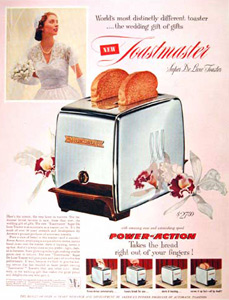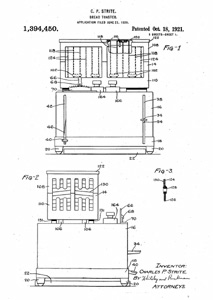 What was the greatest thing since before sliced bread? Why burnt toast, of course!
What was the greatest thing since before sliced bread? Why burnt toast, of course!
Seriously. Without burnt toast, we might never have the modern toaster. And, without the pop-up toaster’s boost by the subsequent invention of sliced bread, we’d probably never have thought of pop-tarts and frozen waffles, either.
Burnt Toast Smell Fills Factory Cafeteria; Sparks Creative Genius
Burnt toast in the company cafeteria at a Stillwater, Minnesota plant lead to the invention of the modern pop-up toaster. Charles Strite, a master mechanic, wanted to take the need for continual human attention out of the process of making toast. Strite added springs and a variable timer to the toaster. The new toaster had a clockwork mechanism that, after a certain adjustable amount of time had elapsed, would turn off the heating elements and trigger the ascension of a spring-loaded basket containing the toasted bread.
 Strite filled an application for a patent on May 29,1919. He received Patent #1,394,450 on October 18, 1921 for a bread-toaster. Strite formed the Waters Genter Company to manufacturer his new toaster, which he intended for use in restaurants. Financial backing from his friends allowed Strite to produce and sell one hundred hand-assembled toasters.
Strite filled an application for a patent on May 29,1919. He received Patent #1,394,450 on October 18, 1921 for a bread-toaster. Strite formed the Waters Genter Company to manufacturer his new toaster, which he intended for use in restaurants. Financial backing from his friends allowed Strite to produce and sell one hundred hand-assembled toasters.
Strite Makes Toasting Easier. Toaster Making? Not So Much.
Hand-assembling the toasters made production very slow. Murray Ireland joined the company in 1925 and redesigned Strite’s original invention so that the toaster could be mass-produced and made readily available to the general public. Ireland’s new take on Strite’s “restaurant ready” toaster could brown bread on both sides, had a timer and ejected the bread when finished. Dubbed “the Toastmaster”, Strite’s design hit the market for consumers in 1926 and had some moderate success. A magazine ad for the product reminded you that you could “make perfect toast every time! Without turning! Without burning!”
Toasters + Sliced Bread. A Match Made in Breakfast Heaven.
In 1928, bread and the success of the toaster were changed forever. Inventor Otto Frederick Rohwedder created the first mechanical bread-slicer. In 1930, the Continental Bread Company began selling the Wonder Bread. Pre-sliced bread slowly became the bread to buy and everyone wanted the Wonder Bread on their table. By 1933, more sliced bread was being sold by American bakeries than unsliced bread.
The popularity of the new standardized slices of bread gave a boost to the toaster. Pop-up toasters became a must have appliance in American homes. The prevalence of pop-up toasters in American homes led to the development of convenience foods designed to be heated in the toaster including frozen waffles and Pop-Tarts.

During breakfast my grandmother would put two slices of white bread into this metallic thing I now know as the toaster and I would patiently watch the bread pop out while my warm Ovaltine cools down. One time, it malfunctioned and she aske done shady electrician to fix it. He pretended like it was hopeless and he never returned it.